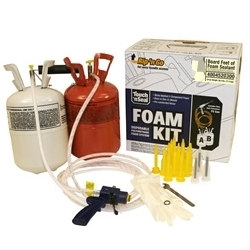
This blog has been updated from previous version published in 2014.
You may be considering using spray foam insulation in your home or commercial space but are unsure what type to use. High Expansion and Low Expansion Foam are the two primary types that are used. Here are the main differences between them.
Uses
Low expansion foam only expands about 10% larger than the output size, so it is used for smaller jobs like:
- cracks and gaps around windows and doors too big for traditional caulk
- plumbing, HVAC, and electrical penetrations
- seams and small openings in framing
Because it expands as much as 5 times the output size, high expansion foam is primarily used for filling big voids, such as:
- rim joists, roof/wall joints, or big gaps in framing
- blind corners
- wall/ceiling intersections
- around boxes over can lights
- Rim joists
- Attics, basements, crawl spaces
- Foundation walls
- Stud cavities
Curing Method
High Expansion foam has two components stored in separate tanks until mixed at the time of spraying. After spraying, it typically cures in less than 2 minutes.
Low expansion foam comes in a single tank or container, and relies on moisture in the air to cure, usually in about 20 minutes. In extremely dry conditions, you may need to use a spritzer to properly cure this type of foam.
Dispensing Method
Since high expansion foam is used for larger jobs and requires separate tanks for the two components, the dispensing systems are typically larger and have two tanks, each with a line connected to the spray gun.
Low expansion foam is typically in smaller containers that can either attach directly to the spray gun or have a single line connecting to a separate, single tank.



